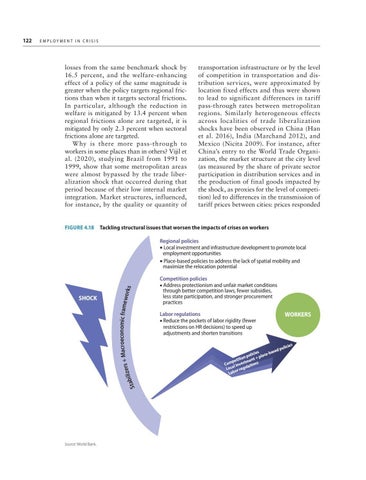122 E m p l o y m e n t
in Crisis
losses from the same benchmark shock by 16.5 percent, and the welfare-enhancing effect of a policy of the same magnitude is greater when the policy targets regional frictions than when it targets sectoral f rictions. In particular, although the reduction in welfare is mitigated by 13.4 percent when regional frictions alone are targeted, it is mitigated by only 2.3 percent when sectoral frictions alone are targeted. Why is there more pass-through to workers in some places than in others? Vijil et al. (2020), studying Brazil from 1991 to 1999, show that some metropolitan areas were almost bypassed by the trade liberalization shock that occurred during that period because of their low internal market integration. Market structures, influenced, for instance, by the quality or quantity of
transportation infrastructure or by the level of competition in transportation and distribution services, were approximated by location fixed effects and thus were shown to lead to significant differences in tariff pass-through rates between metropolitan regions. Similarly heterogeneous effects across localities of trade liberalization shocks have been observed in China (Han et al. 2016), India (Marchand 2012), and Mexico (Nicita 2009). For instance, after China’s entry to the World Trade Organization, the market structure at the city level (as measured by the share of private sector participation in distribution services and in the production of final goods impacted by the shock, as proxies for the level of competition) led to differences in the transmission of tariff prices between cities: prices responded
FIGURE 4.18 Tackling structural issues that worsen the impacts of crises on workers
s ilizer Stab
SHOCK
+ Macroeconomic framework s
Regional policies • Local investment and infrastructure development to promote local employment opportunities • Place-based policies to address the lack of spatial mobility and maximize the relocation potential
Source: World Bank.
Competition policies • Address protectionism and unfair market conditions through better competition laws, fewer subsidies, less state participation, and stronger procurement practices Labor regulations • Reduce the pockets of labor rigidity (fewer restrictions on HR decisions) to speed up adjustments and shorten transitions
WORKERS
cies poli sed s a e b i c poli + place t tion peti estmen ns m o v C o i n t i l a l Loca or regu Lab

